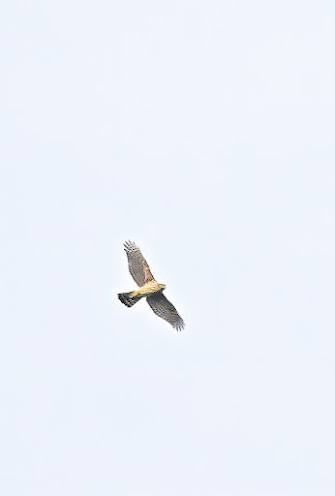West coast birders have been seemingly knee-deep in American warblers and vireos over the past week or so. It has been incredibly exciting watching events unfold online, and seeing the first jaw-dropping photos of these trans-Atlantic super-jewels appear. It has been really cool and I am not in the least bit envious, no. I am; massively!
Of course, what is good weather for cross-pond vagrancy is pretty dire for the east coast and looking ahead to early October, it is looking bleak, without a hint of east for the next fortnight. Despite the doom and gloom, it has been an exciting week with the first Yorkshire Sharp-tailed Sandpiper in a few years found by Alan Davies at Blacktoft Sands on the Humber. Alan was visiting from Wales - as if he didn't have enough birds to enjoy back home!! Fair play Alan, a great and well-deserved find.
I headed up there before work earlier this week, but sadly the bird had been flushed minutes before I arrived and despite checking the other pools and Singleton lagoon over and over, it did not reappear, so I left for work, feeling a little glum.
I have seen one British Sharpy before - see here - but I would love to see one in the home county. To be fair, it was a cracking hour spent grilling the waders, with five or so Curlew Sandpipers, 12 Spotted Redshanks and 3 Greenshanks the highlights. A Water Rail skulked along a reedy edge and a Marsh Harrier quartered the reedbeds. Nice. I spent a lot of my formative birding years with my Dad and his mate John, watching waders here, but these days I come here infrequently- not sure why as it is a cracking place.
...
Later that day, another cracking bird was discovered in God's own. Nick Addey, up at Long Nab, Burniston, had found an Eastern Olivaceous Warbler. Now, this is a proper bird! Not your gaudy, technicolour Yank sprite, but a real identification-prowess-testing skulker. How it had landed up on the east coast in a southwesterly, I do not know, but perhaps there had been something going on, as there had been a few other south-east European bits on the coast nationally, dropped in by rain during the last few days perhaps. Either way, this was a quality bird for the UK, let alone Yorkshire and the pics of the bird coming from Long Nab were amazing. I was not around for the Flamborough Eastern Olly (the only previous county record, back in 2010) and the only one I'd twitched was a bird at Benacre, Suffolk in 1995 while I was at Uni, which I dipped, so this was a must-see bird.
Pipe Gulley, near Long Nab.
So, another early start and a dawn raid on the east coast. Shortly before I arrived, the welcome news came through that the bird was still present. Great! I picked up a young birder who had parked at the village - Austin from Wigan - and drove down the lane to the car park. After a short squelchy walk down the clifftop path, we spotted about a dozen birders actively looking into the gulley below. Within minutes, I could hear the 'tecking' call of my target, and seconds later, a pale warbler flicked on to the edge of the Blackthorn. Result! Characteristically flicking its tail down like an out-sized Chiffchaff and clambering around in the bushes, snapping hoverflies from the bindweed flowers, it showed brilliantly well. It had the feel of an Icterine Warbler in Marsh Warbler clothing, with lovely pale fringing on the tertials, coverts and on it's long primary tips. Strangely, I was expecting the bird to have dark lores, but this bird had very clearly pale lores, giving it quite an open-face. I checked this out in the Handbook later and actually the face pattern matched most of the pics, reminding me always to check more than one source of info! There was a hint of a dark upper border to the lores, a bit Booted Warbler-esque. The bill was narrow though, as expected and the paleish outer tail feathers were obvious, especially when the bird was against the dark foliage.
Eastern Olivaceous Warbler, Burniston. Phonescoped.The warbler seemed to be following a circuit round the bushes and could be tracked through its 'teck' call, which it gave frequently. It would occasionally sit motionless out in the open on a briar or twig, seemingly looking for an insect, before a quick burst of activity, as it moved through the bushes, or lunged after a prey item. It wasn't easy to phonescope, but I managed to get a view dodgy clips in the early morning light:
On views like this, the bird really was quite distinctive, helped by the call and tail-dipping. I could have quite easily watched this smart and educational bird all morning, but like with yesterday, time was ticking by and I had to get on, so I left, giving Austin a lift back to his car on the way out.
A Chiffchaff and Blackcap were present in the bushes too.
...
A further twist in this tale, was that the Sharp-tailed Sandpiper appeared again early morning at Blacktoft. So, you never know, I may get another shot at that too, before the week is out.
























